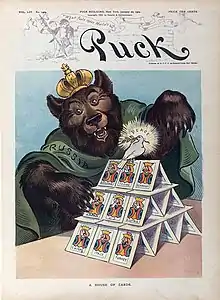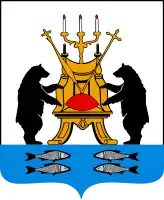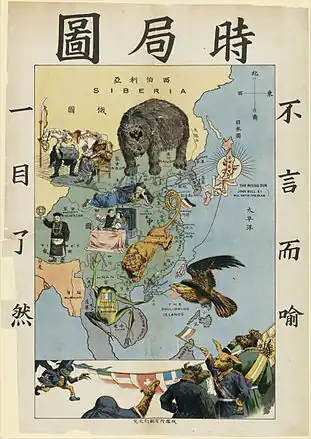
The Russian Bear (Russian: Русский медведь, romanized: Russky medved) is a widespread symbol (generally of a Eurasian brown bear) for Russia, used in cartoons, articles and dramatic plays since as early as the 16th century,[1] and relating alike to the Russian Empire, the Russian Provisional Government and Russian Republic, the Soviet Union, and the present-day Russian Federation.
The uses of the bear are mixed. It was often used by Westerners, in British caricatures and later also used in the United States, often not in a positive context. On occasion it was used to imply that Russia is "big, brutal and clumsy". However, Russians have also used it to represent their country, where it has been used as a "symbol of national pride."[2]
Early history
Use in Russian coats of arms
There have been a few examples of Russians depicting bears in coats of arms, mainly showing polar bears and brown bears.[3] The Novgorod Oblast coat of arms and flag include two brown bears.[3] The Republic of Marii El's coat of arms is a red bear with a sword and shield.[3] The coats of arms of Nenets Autonomous Okrug and Chukotka Autonomous Okrug have polar bears.[3] Meanwhile, the Republic of Karelia and Khabarovsk Krai have black bears in their coat of arms.[3]
In the arms of Perm Krai and the Republic of Karelia, a bear symbolizes how Orthodox Christianity took over from bear cults. Despite the bear's symbolism inside Russia, the local coat of arms uses the bear to reflect the region and its history rather than Russia as a whole.[3]
Beginning of the use in the West
The idea of the Russian bear that pushes Russianness first appeared not in Russia but in the West.[4] It is unknown when the Russian bear was first used in the West.[4] One of the earliest usages of the Russian bear was from William Shakespeare's Macbeth in Act 3, Scene 4. Where Shakespeare referred to a "rugged Russian bear."[4]
In Maps
Multiple maps from the 17th to the 20th centuries show Russia as inhabited and represented by bears.[4][5] The maps started with small bears to represent Russia.[4] The small use of the Russian bear led one scholar to suggest that the West viewed Russia as "realms for wild animals" by pointing out the comparison between the bears in Russia and the lions in North Africa.[4] Over time these bears started to represent the entire country.[3] In the end, the bears became connected with the idea of Russia, rather than small animals on the map, especially through satirical maps.[5]
In cartoons
The Russian bear has also been depicted in political cartoons, especially in the British publication Punch.[4] One of the earliest uses of the bear's connection to Russia was in the late 18th century, when a British cartoon put Catherine the Great's head on a body of a bear ridden by Russian General Grigory Potemkin.[4] The Napoleonic Wars also had bears used to represent Russia alongside other animals, such as the Lion of England.[4] During the Crimean War, Russia was portrayed as a bear multiple times, especially in Punch cartoons showing a bear holding a turkey representing the Ottoman Empire which is given the subtitle "Turkey in danger?" [4] Representation of the Russian bear continued in cartoons throughout the 19th century and the early 20th century.[4] In the First World War, many Punch cartoons referred to Russia using a bear to represent the empire.[4]
The cartoons, however, did not always represent Russia through war or expansion but also used the bear to describe internal problems.[4] Sometimes the bear is shown as injured from war or internal problems.[4] Especially after the January Uprising in Poland, a Russian bear is portrayed fighting a woman who represents the Poles.[4]
Use in the Soviet era
The bear image was, however, on various occasions (especially in the 20th century) also taken up by Russians themselves. Having the bear cub "Misha" as the mascot of the 1980 Moscow Olympic Games was evidently intended to counter the "big, brutal Russian Bear" image with a small, cuddly, and smiling bear cub.
In Ronald Reagan's successful campaign to be re-elected President of the United States in 1984, he used the bear motif in the famous "Bear in the woods" ad. It claimed that Reagan recognized the existence of a Soviet threat to the United States and the "First World", while his opponent Walter Mondale denied its existence.
Use in post-1991 Russia
After the dissolution of the Soviet Union, there was some support in the Russian Parliament for having a bear as the new Russian coat of arms, with the supporters pointing out, "Russia is anyway identified in the world with the Bear". Eventually, however, it was the Tsarist-era coat of arms of the double-headed eagle that was restored.
In Russia, associations with the image of the bear have received relatively mixed reactions. On one hand, Russians themselves appreciate the bear for its raw power and cunning, and bears are very often used as mascots or as a part of a design on a logo. On the other hand, the overuse of the image of the bear by foreigners visiting Russia prior to 20th century led to the image of bear being a sort of insider joke that postulates that "Russian streets are full of bears" as an example of factually-inaccurate information about Russia.
Later, the bear was taken up as the symbol of the United Russia Party, which has dominated political life in Russia since the early 2000s. Coincidentally, the surname of Dmitry Medvedev, the Russian president elected in 2008, is the possessive adjective of медведь, meaning "of the bears".
Gallery
From Russia
 Misha the teddy bear, the mascot of Moscow Olympics (1980)
Misha the teddy bear, the mascot of Moscow Olympics (1980) Banner depicting the Russian Bear unfurled by Russian football supporters (the inscription says "Forward, Russia!").
Banner depicting the Russian Bear unfurled by Russian football supporters (the inscription says "Forward, Russia!"). Coat of arms of Novgorod
Coat of arms of Novgorod The humorous image of four-pawed double-headed bear posing as double-headed eagle
The humorous image of four-pawed double-headed bear posing as double-headed eagle
From outside Russia
 British political cartoon concerning Napoleon's invasion of Russia 1804.
British political cartoon concerning Napoleon's invasion of Russia 1804. The Russian Bear (sitting, to the right) among the European powers courted by Bismarck in order to isolate France.
The Russian Bear (sitting, to the right) among the European powers courted by Bismarck in order to isolate France. A humoristic Japanese world map representing Russia as a big bear
A humoristic Japanese world map representing Russia as a big bear.jpg.webp) Cartoon from the English satirical magazine Punch, or The London Charivari. With the Russian Bear sitting on the tail of the Persian cat while the British Lion looks on, it represents a phase of The Great Game. The caption reads: "AS BETWEEN FRIENDS. British Lion (to Russian Bear). 'IF WE HADN'T SUCH A THOROUGH UNDERSTANDING I MIGHT ALMOST BE TEMPTED TO ASK WHAT YOU'RE DOING THERE WITH OUR LITTLE PLAYFELLOW.'"
Cartoon from the English satirical magazine Punch, or The London Charivari. With the Russian Bear sitting on the tail of the Persian cat while the British Lion looks on, it represents a phase of The Great Game. The caption reads: "AS BETWEEN FRIENDS. British Lion (to Russian Bear). 'IF WE HADN'T SUCH A THOROUGH UNDERSTANDING I MIGHT ALMOST BE TEMPTED TO ASK WHAT YOU'RE DOING THERE WITH OUR LITTLE PLAYFELLOW.'" Chinese view of THE SITUATION IN THE FAR EAST, 1905. Bear for Russia intruding from the north, bulldog for the United Kingdom in south China, frog for France in southeast Asia, and American eagle for the United States approaching from the Philippines.
Chinese view of THE SITUATION IN THE FAR EAST, 1905. Bear for Russia intruding from the north, bulldog for the United Kingdom in south China, frog for France in southeast Asia, and American eagle for the United States approaching from the Philippines. The reverse of a World War I German Silver medallion liberation of East Prussia 1914 by Paul von Beneckendorff und von Hindenburg. Referring to the Battle of Tannenberg. The naked General Hindenburg fighting the Russian Bear with his sword.
The reverse of a World War I German Silver medallion liberation of East Prussia 1914 by Paul von Beneckendorff und von Hindenburg. Referring to the Battle of Tannenberg. The naked General Hindenburg fighting the Russian Bear with his sword.
References
- ↑ Christine Ammer, It's Raining Cats and Dogs and Other Beastly Expressions (BookBaby, 2012)
- ↑ Platoff, Anne M.; North American Vexillological Association / Association nord-américaine de vexillologie (2012). "The "Forward Russia" Flag: Examining the Changing Use of the Bear as a Symbol of Russia". Raven: A Journal of Vexillology. 19: 99–126. doi:10.5840/raven2012197. ISSN 1071-0043.
- 1 2 3 4 5 6 7 Platoff, Anne M.; North American Vexillological Association / Association nord-américaine de vexillologie (2012). "The "Forward Russia" Flag: Examining the Changing Use of the Bear as a Symbol of Russia". Raven: A Journal of Vexillology. 19: 102–104. doi:10.5840/raven2012197. ISSN 1071-0043.
- 1 2 3 4 5 6 7 8 9 10 11 12 13 14 15 Platoff, Anne M.; North American Vexillological Association / Association nord-américaine de vexillologie (2012). "The "Forward Russia" Flag: Examining the Changing Use of the Bear as a Symbol of Russia". Raven: A Journal of Vexillology. 19: 104–113. doi:10.5840/raven2012197. ISSN 1071-0043.
- 1 2 Barron, Roderick M. (2008-12-31). "Bringing the map to life: European satirical maps 1845-1945". Belgeo. Revue belge de géographie (3–4): 445–464. doi:10.4000/belgeo.11935. ISSN 1377-2368.
External links
![]() Media related to Russian Bear at Wikimedia Commons
Media related to Russian Bear at Wikimedia Commons
- Rossomakhin, A.; Khrustalev, D. (2008). "Russia as a Bear: origins of the visualization (16th–18th centuries)" (in Russian). IvSU.
{{cite journal}}: Cite journal requires|journal=(help) - Rossomakhin, A.; Khrustalev, D. (2008). "Russia as a Bear". Neprikosnovennyy Zapas (in Russian). 1 (57). Archived from the original on 2011-07-23.